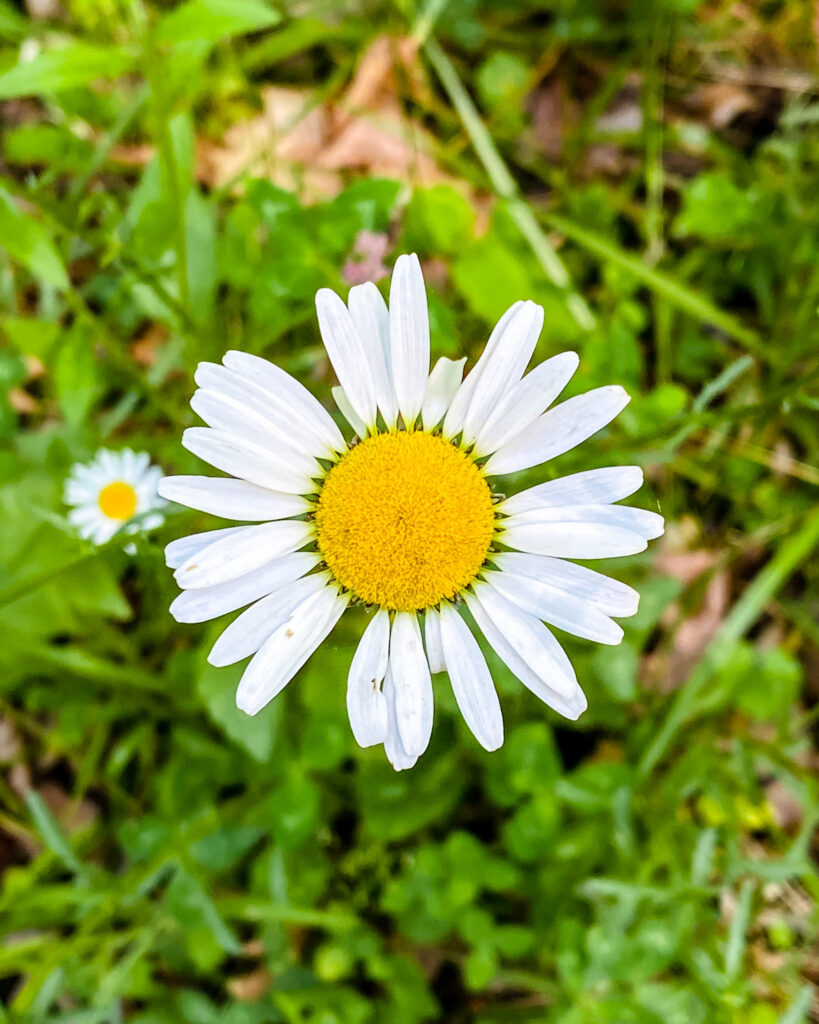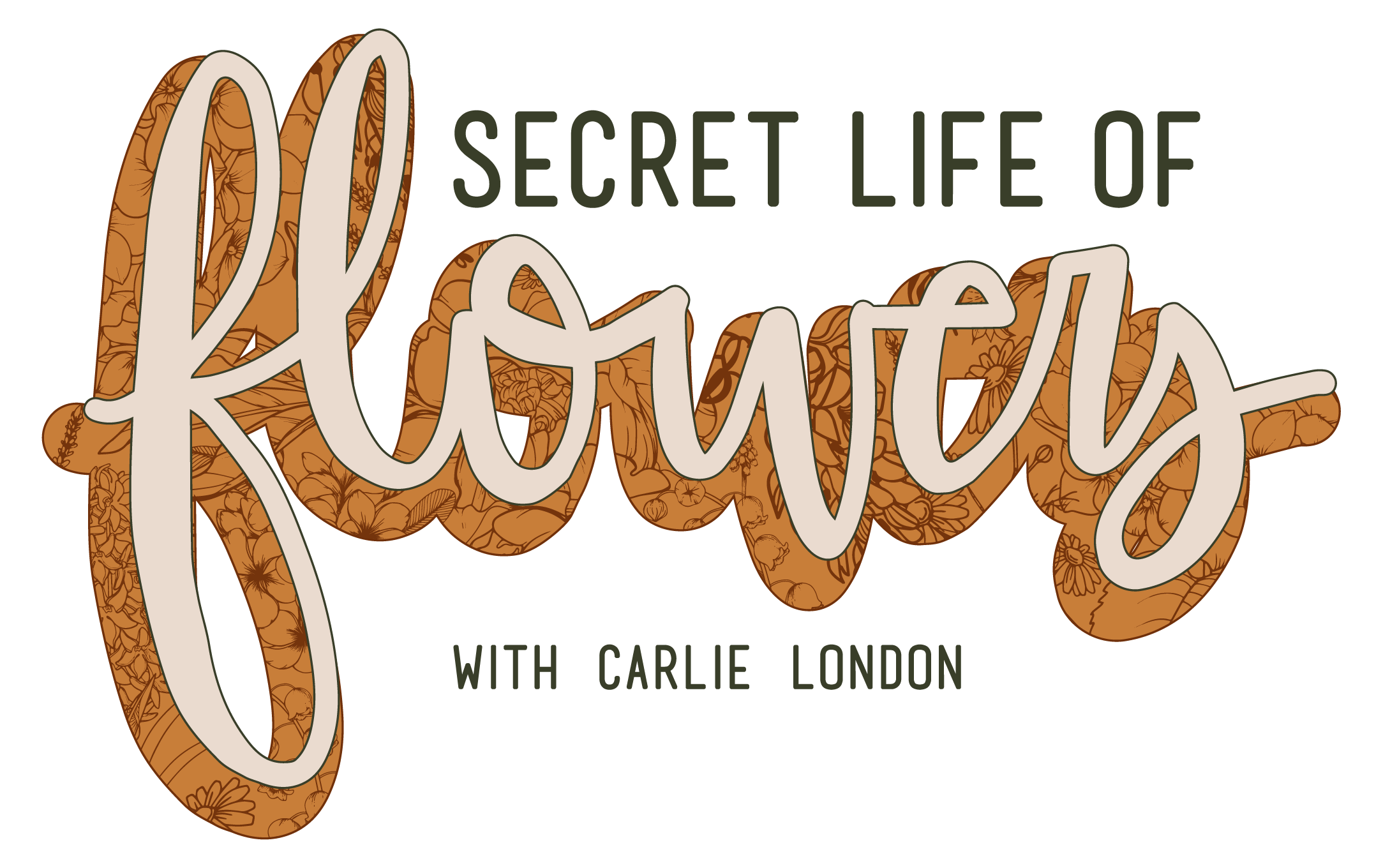Daisies
Daisy – Podcast S1 E2 – October 19, 2020
I’m Carlie, not a botanist, just an artist obsessed with all things flowers, especially the language of flowers, and here to share with all of you flower lovers out there. You may want to learn some flower history, learn how to utilise the language of flowers to say or decorate with purpose, or some very beginner herbalist ideas, that you should definitely not take my word for, research yourself, or talk to a professional.
Daisies, picked for my dynamite friend, Minnow, that I made while hiking the Appalachian Trail. Common Daisies are of the Asteraceae or Compositae, which is a very large and widespread family of flowering plants. The family includes over 32,000 currently accepted species. In terms of numbers of species, the Asteraceae are rivalled only by the Orchidaceae. So, you probably guessed it, I am jumping into common daisies or daisies as a hole rather than focusing on one particular variation.

Meaning:
They symbolise innocence, cheer, love you truly, purity, loyal love, I’ll never tell, I share your sentiment, farewell, afterthought, beauty, I will think of it, motherhood and childbirth, sensuality, fertility, and new beginnings. The most common meanings being innocence, purity, and love, but just like with many flowers different types, colours, or locations can have varying symbolism.
meanings by colour are as such:
- white – innocence, purity, spirituality, new beginnings
- yellow – happiness, cheer, friendship
- pink – love, romance, feminine energy
- red – true love, passion
meanings according to a few different types of daisies:
- garden – I share your sentiment
- michaelmas (mick-ul-mas) – farewell, afterthought
- parti-coloured – beauty
- wild – I will think of it
How to pair these flowers:
When giving daisies or decorating with them, you should consider what it is you are wanting to say. Make sure to pair it with other flowers that also symbolise the message you want to send, so it can’t be confused.
For example, in a wedding bouquet, where you are probably wanting to say things like love, passion, forever, etc, then pair red, white, pink, or garden daisies with roses, orange blossoms, lilies, asters, peonies, sunflowers, red or white chrysanthemum, or tulips
If you are wanting to give a true friend a nice bouquet then any colour of daisy, or garden daisies, paired with almost any yellow flower, ivy, alstroemeria, acacia, oak-leaved geranium, or wisteria
If you would like to decoration your home with cheer then I suggest yellow daisies to be paired with elderflower, ranunculus, or birds of paradise
For a bit of Daisy history:
- They are one of the two official birth flowers for April, which happens to be my birth month.
- “daisy” is a derivative of the old english name, which meant “days eye” which is fitting considering their petals open at dawn and close at dusk. This is also how we get the saying “fresh as a daisy” referring to someone who is bright and cheery in the morning, just like a daisy. I must say, no one has ever used that saying when talking about me…I need time and coffee before I reach cheery!
Daisies also have lots of history is various mythologies.
- In Roman mythology the god of seasons and gardens, Vertumnus, like many Roman gods, desired beautiful women. One day, he saw the wood nymph, Belides, dancing with other innocence nymphs and he wanted her for himself. But she did not want him. To escape him, she turned herself into a Bellis flower. Which is where we get the latin name for Daisy.
- In Norse mythology, the vikings goddess of love, Freya, gave the flower its meaning. It symbolised motherhood and childbirth and in relation to that it also meant sensuality and fertility.
- In ancient Celtic mythology, the daisy had a deeper and more powerful meaning. When a child died (particularly one that died during childbirth) the gods would sprinkle the child’s grave with daisies to cheer up the grieving parents. Believing them to come from the child’s spirit.
- Victorian maidens would pluck daisy petals and ask “he loves me, he loves me not” hoping the object of their affections felt the same. Hopefully she picked up an odd-petaled daisy…
- In the Christian religion the daisy is representative of the Virgin Mary.
It is likely that daisies originally come from Europe. However, their popularity fuelled their distribution world wide. In the United States daisies grow wild all over. Because of this they are sometimes called a “common weed”.
Daisies are on every continent, except Antarctica. They often inhabit grasslands, meadows, gardens, urban areas, and roadsides.
Here are some of the uses of Daisies. I would like to preface this with, I am not a herbalist, please do your own research, I am just sharing what I have learned.
- Wild Daisies (also known as common daises and a bunch of other names), made into a tea, helps with coughs, bronchitis, disorders of the liver and kidneys, and swelling (inflammation).
- They can be a drying agent “blood purifier”
- Some take a homeopathic wild daisy for preventing problems during childbirth, pain and soreness, and minor bleeding.
- Placing them directly on the skin can help minor wounds and diseases.
- Modern analysis of the daisy shows that is contains nearly as much vitamin C as lemons.
- Other, non-medicinal uses of the daisy, well, you can put them in salads, smoothies, desserts, and use them to make a daisy tea, which I haven’t tried but hear has a mild lemon-y taste!
What can you do to keep yours alive and thriving – spoiler these are easy flowers to take care of for all of you green thumb dreamers!
- Plant your daisy seeds directly into your garden, in early spring, after the last frost. Seeds will germinate 10-20 days and won’t bloom the first year. Start the seeds indoors if you want them to bloom their first year. They like full sun, fast-draining soil, soil pH measuring 6-8, and plenty of water. But considering they pop up all over, you can probably take a less hands on approach and they will do just fine!
- Water them during dry spells and during their blooming season. Also, give them all-purpose, organic fertiliser early in the season to promote strong, sturdy growth.
- Deadhead the flowers when they fade or die, this encourages more blooming and it keeps dead flowers from molding and decaying on your plant.
- Daisies really are a very hands-off flower that require minimal work. There are so many types of daisies, here are some low maintenance, perennial types to add to your gardens (besides the common daisy): blue-eyed beauty, shasta, pink shimmer, painted, and marguerite (mar-ger-eat)
- A couple more things to note, Daisies can be either annuals or perennials and come from seeds.
That is all I have for Daisies!
If you have heard any other uses, meanings, or are an expert then I would love you to leave a comment and share what you know or have learned! If you are interested in purchasing ad space or paying for a friend’s birthday shout out, then fill out the contact form on my website. You will also find all of my sources, under the sources tab. Thanks for listening, see you again in two weeks with a new flower!
